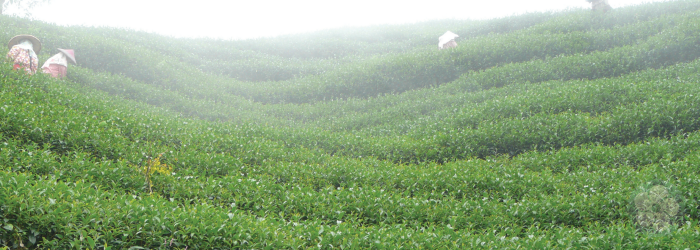A Brief History of Taiwanese Teas

Today, the tiny island of Taiwan is known around the world for its teas. Rolled oolongs grown at high elevations have inspired myriad copycats, Taiwanese black teas are rapidly gaining popularity, and the domestic tea culture has exploded. But in the vast historical context of Chinese tea, Taiwan is a relative newcomer. How has this island gone from provincial backwater to a leader of the global tea industry?
Dynastic Rule under the Qing
The earliest colonial power in Taiwan was the Dutch, who encouraged Chinese immigration from the mainland for labor in growing sugar and rice. The Dutch were expelled from Taiwan by the Qing Dynasty in 1662, though the Kangxi Emperor took little interest in incorporating the island into imperial China. Despite early restrictions on immigration, trade brought tea plants from Wuyi Shan to Taiwan in the early 18th century.
Though sugar and rice still dominated the island’s economy, the global tea market was picking up steam. In 1865, shortly after the Second Opium War, while the British were building the Indian tea industry, a merchant named John Dodd arrived in Taiwan. To his surprise, he discovered a burgeoning tea market.

The Taiwanese were crafting oolong teas, unique from the green and black teas usually seen in Europe, and Dodd recognized the commercial potential. He invested in local tea production, building factories and allowing tea farmers in Northern Taiwan to control the process from start to finish. His new “Formosan Oolong” teas were shipped to England and New York, where they gained particular renown and prompted other exporters to follow suit. By the end of the 19th century, tea was one of Taiwan’s primary exports.
Japanese Occupation
The Qing Dynasty ceded Taiwan to Japan at the end of the Sino-Japanese War, in 1895. The Japanese continued developing tea production in Taiwan, encouraging cultivation of local varieties as well as introducing black tea varieties like Assam, in an effort to avoid direct competition with Japanese green teas. In 1903, they established the Tea Manufacture Experiment Station to conduct research on varieties and crafting processes. This institution still exists today, though it is now called the Taiwanese Research and Extension Station.

The Japanese also brought industrialization to Taiwan, particularly after 1930. Most notably, a vast swamp in central Taiwan was transformed into a hydraulic dam, forming Sun Moon Lake in Nantou County. Today, the lake is a popular tourist destination, as well as the center of black tea production on the island.
The Republic of China
After the end of World War II, Taiwan was granted to the Republic of China. At the same time, a civil war raged in China between the Nationalists, led by President Chiang Kai-Shek, and the Communist Party of China, led by Mao Zedong. When the Communists took control of the mainland, Chiang Kai-Shek and his followers retreated to Taiwan, establishing the new capital of the Republic of China in Taipei. Embargos placed on communist China boosted sales of Taiwanese teas, and for several decades Taiwanese tea farmers focused on making traditional Chinese styles to satisfy the global market.
In the late 20th century, however, Taiwan found itself in competition with China and Japan, who were re-establishing their place in the tea trade as they recovered from World War II. To diversify, Taiwan’s tea industry turned back to the oolong teas that had first gained ground in America. With established infrastructure, a booming economy, and a unique domestic tea culture, Taiwan was now poised to become a world leader in tea.

None of this would have been possible, of course, without Taiwan’s tropical climate and rich, volcanic soil. The island itself is like a tea plants’ paradise, while varied terrain creates a range of local specialties. Gaoshan (“high mountain”) oolongs are some of the island’s most famous, but we find that Taiwanese black teas can be stunningly flavorful and naturally sweet, as well.
Do you have a favorite Taiwanese tea? Let us know in the comments!
Sign up for our newsletter to get blog updates in your inbox!



Comments on this post (0)